DOLPi – Two Low-Cost, RasPi-based Polarization Cameras for Humanitarian Demining and other Applications
The project's blog is at: http://www.diyphysics.com/
A complete project description including detailed construction instructions and Python code is available in pdf format at: http://www.diyphysics.com/wp-content/uploads/2015/10/DOLPi_Polarimetric_Camera_D_Prutchi_2015_v5.pdf
Or from HERE (Dropbox download)
Mirror backup site for the project description at: http://www.prutchi.com/wp-content/uploads/2015/10/DOLPi-v5.0.pdf
All files available from Dropbox. CLICK HERE to be taken to DOLPi folder.
Images and text (c) 2015 David Prutchi unless otherwise stated.
NOTE: The space available for the project description in Hack-A-Day.IO is limited, so the following "detailed description" is just a brief summary of the most significant aspects of the DOLPi Project. If interested in this project, please download instead the complete project whitepaper available as a single pdf file at: http://www.diyphysics.com/wp-content/uploads/2015/10/DOLPi_Polarimetric_Camera_D_Prutchi_2015_v5.pdf
Summary
This project presents the development and construction of two low-cost polarimetric camera types based on the Raspberry Pi 2. DOLPi-MECH (and its productized IR-VIS-UV version DOLPi-UI) is a filter-wheel-type camera capable of performing full Stokes analysis, while the electro-optic based DOLPi-EO camera performs full linear polarimetric analysis at higher frame rate. Complete Python code for polarimetric imaging is presented. Various applications for the cameras are described, especially their use for locating mines and unexploded ordinance in humanitarian demining operations.
A complete project description including detailed construction instructions and Python code is available in pdf format at: http://www.diyphysics.com/wp-content/uploads/2015/10/DOLPi_Polarimetric_Camera_D_Prutchi_2015_v5.pdf
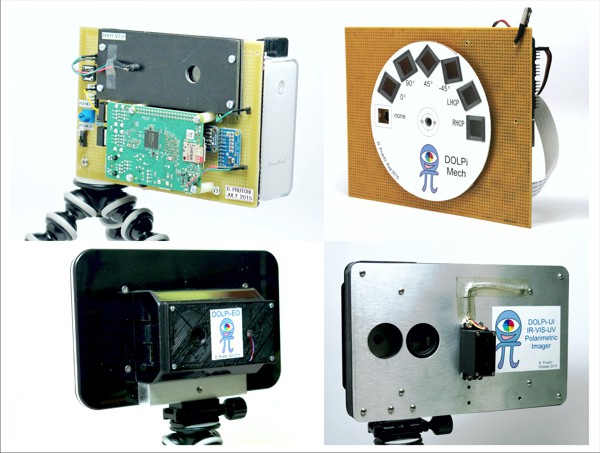
The DOLPi Project
Clouds of colorless pollutants, antipersonnel mines, and skin cancers are so difficult to detect because they blend so naturally with their background that our unaided eyes cannot see them. However, an octopus faced with the same problem would probably have a very easy time at locating these threats. This is because our human eyes can only distinguish objects from their background through the contrast in their color and/or intensity. On the other hand, octopuses would be able to see the contrast in light polarization between these items and their background.
Try this experiment - next time that you go outdoors on a sunny day, tilt your head while wearing polarized sunglasses. You will find that parts of the sky turn into a lighter shade of blue when you turn your head sideways. The intensity of the glare will also change considerably as you tilt your head while looking at a reflective surface like still water, or the windshield of a car. Look at a static scene like a parking lot while tilting your head back and forth – do the windows of parked cars seem to flash? The reason for this phenomenon is that the light scattered by the sky, or reflected by many surfaces is “polarized”. That is to say that light waves from these sources vibrate mainly in one direction.
In fact, every photon that reaches our eyes has its own polarization, yet this aspect of light is barely used in our daily life because our unaided eyes are insensitive to polarization, and thus we don’t have an intuitive sense for its use (actually, humans have very marginal sensitivity to polarized light as discovered by Haidinger in 1846, but changes in polarization can only be perceived under very specific conditions and do not contribute to visual feature discrimination).
In spite of this, polarization of light carries interesting information about our visual environment of which we are usually unaware. Some animals have evolved the capability to see polarization as a distinct characteristic of light, and rely critically on this sense for navigation and survival. For example, many fish, amphibians, arthropods, and octopuses use polarization vision as a compass for navigation, to detect water surfaces, to enhance the detection of prey and predators, and probably also as a private means to communicate among each other.
While we have used technology to expand our vision beyond the limits of our ordinary wavelength and intensity sensitivities, the unintuitive nature of polarization has slowed down the development of practical applications for polarization imaging. Polarization cameras do exist, but at over $50,000, they are mostly research curiosities that have found very few practical uses outside the lab.
The DOLPi project aims to widely open the field of polarization imaging by constructing a very low cost polarization camera that can be used to research and develop game-changing applications across a wide range of fields – spanning all the way from environmental monitoring and medical diagnostics, to security and antiterrorism applications.
The DOLPi polarization camera is based on a standard Raspberry Pi 2 single-board computer and its dedicated 5MP camera. What makes the DOLPi unique is that the camera sits behind a software-controlled electro-optic polarization modulator, allowing the capture of images through an electronic polarization analyzer. The modulator itself is hacked from a low-cost auto-darkening welding mask filter ($9 on eBay®). In spite of its simplicity, DOLPi produces very high quality polarization images. The construction of a slower, but more accurate filter-wheel-based polarimetric camera (DOLPi-Mech and its productized version DOLPi-UI is also presented.
This is a first-of-its-kind project!I am not aware of any polarization imager ever presented as an enthusiast-level DIY project, yet it holds truly awesome disruptive power for the development of brand new scientific and commercial applications!
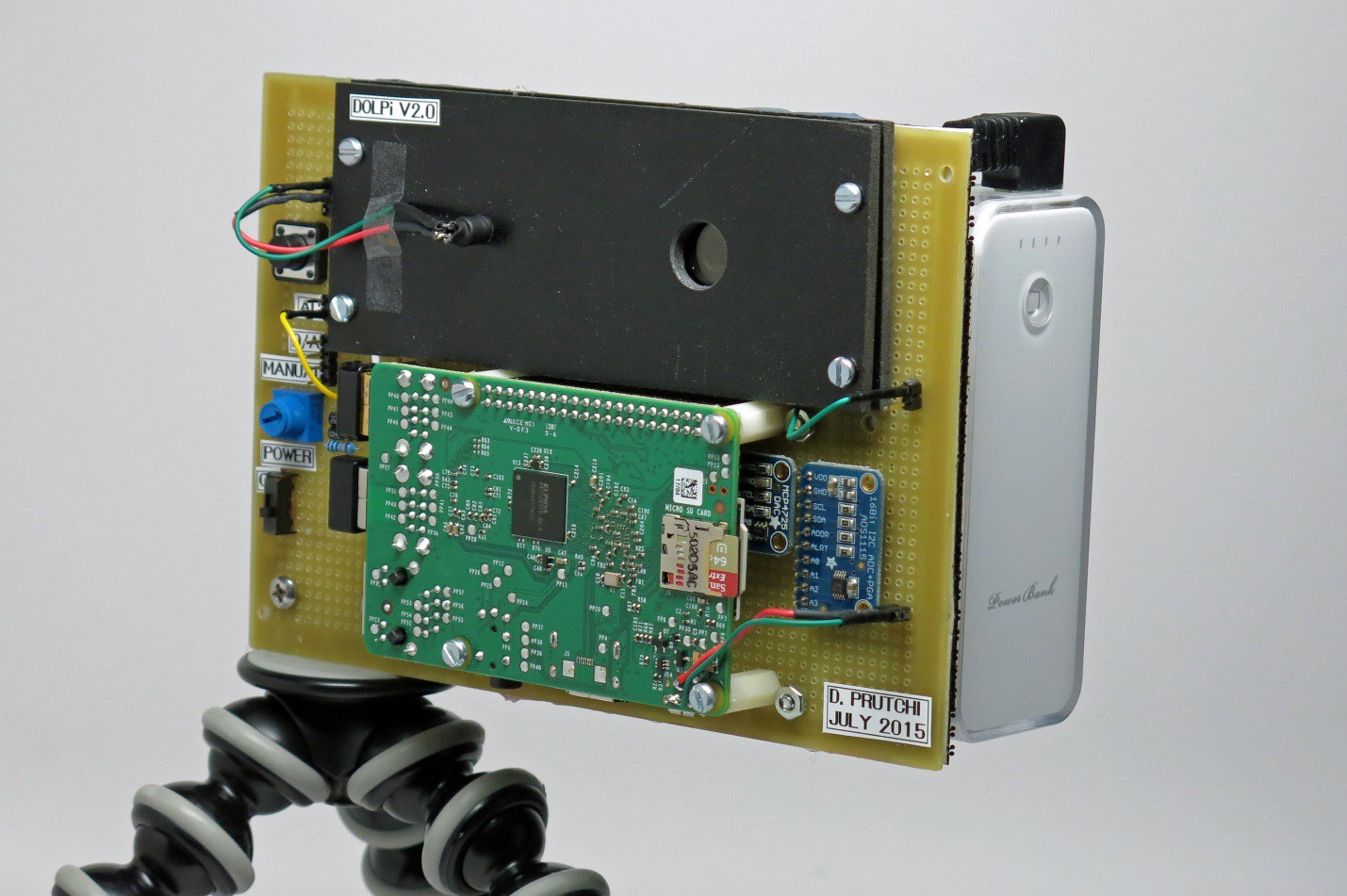
The DOLPi camera is fully self-contained so it can be easily taken wherever needed to perform high-quality polarization imaging, rendering not only the images corresponding to the linear Stokes parameters, but also to Polarization Intensity, Degree of Linear Polarization, Angle of Polarization, and their HSV rendering.

The productized version of the electro-optical DOLPi polarimetric camera is self-contained and incorporates RPi Foundation’s official 7” touchscreen display into a single enclosure.Shown in this photograph is my daughter Abigail helping me run a simulated landmine detection test.
About the name "DOLPi"
Although DoLP refers only to the Degree of Linear Polarization, I liked the name DOLPi as a combination of DOLP and Pi (for Raspberry Pi).The logo is a one-eyed octopus (squids have polarization-sensitive eyes) with “Pi” as its tentacles.
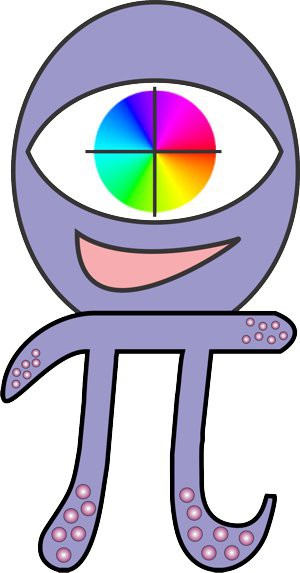
Polarization and Polarizers
Polarization is an important characteristic of light that stems from its nature as an electromagnetic wave. In 1860, Scottish physicist James Clerk Maxwell figured out that an electric field that varies along space generates a magnetic field that varies in time and vice versa. For that reason, as an oscillating electric field generates an oscillating magnetic field, the magnetic field in turn generates an oscillating electric field, and so on. These oscillating fields together form the electromagnetic wave shown in the following figure:

An oscillating electric field generates an oscillating magnetic field, the magnetic field in turn generates an oscillating electric field, and so on. These oscillating fields together form an electromagnetic wave with wavelength λ that propagates at the speed of light. Adapted with permission from D. Prutchi and S.R. Prutchi, Exploring Quantum Physics through Hands-On Projects, John Wiley & Sons, Inc., 2012.
In a wave of polarized light, like the one shown in the figure, the electric field oscillates in one plane, while the magnetic field oscillates on a perpendicular plane. The wave travels at the speed of light along the line formed by the intersection of those planes. The electromagnetic wave shown in this figure is said to be “vertically polarized” because the electric field oscillates vertically in the frame of reference that we have chosen.
Light from most natural sources contains waves with electric fields oriented at random angles around its direction of travel. A wave of a specific polarization can be obtained from randomly-polarized light by using a polarizer filter. As shown in the following figure, a polarizer can be made of an array of very fine wires arranged parallel to one another:
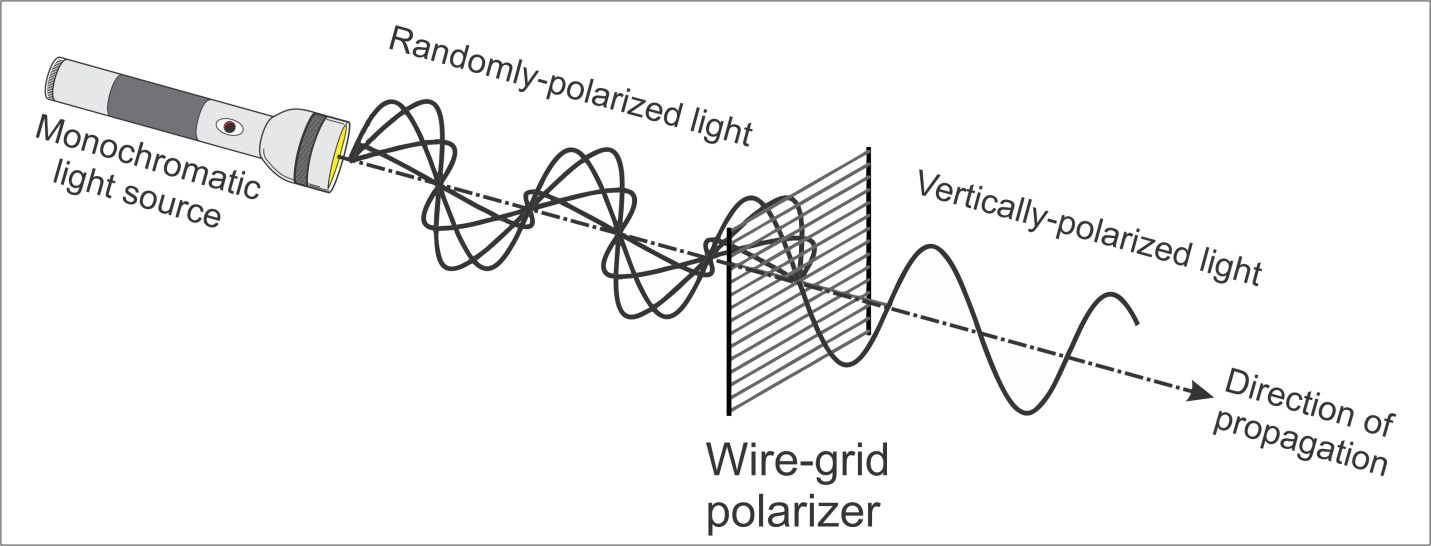
A parallel-wire polarizer absorbs electric-field lines that are parallel to the wires.Only the perpendicular electrical field component of light is allowed to pass, producing light that is polarized perpendicularly to the direction of the wires.Adapted with permission from D. Prutchi and S.R. Prutchi, Exploring Quantum Physics through Hands-On Projects, John Wiley & Sons, Inc., 2012.
The metal wires offer high conductivity for electric fields parallel to the wires, essentially “shorting them out” and producing heat. Because of the nonconducting spaces between the wires, no current can flow perpendicularly to them. As such, electric fields perpendicular to the wires can pass unimpeded. In other words, the wire grid, when placed in a randomly-polarized beam, drains the energy out of one component of the electric field and lets its perpendicular component pass with no attenuation at all. Thus, the light emerging from the polarizer has an electric field that vibrates in a direction perpendicular to the wires.
In 1938 E. H. Land invented the H-Polaroid sheet, which acts as a chemical version of the wire grid. Instead of long thin wires it uses long thin polyvinyl alcohol molecules that contain many iodine atoms. These long, straight molecules are aligned almost perfectly parallel to one another. Because of the conductivity provided by the iodine atoms, the electric vibration component parallel to the molecules is absorbed. The component perpendicular to the molecules passes on through with little absorption.
The amount of polarized light that passes through a polarizer depends on the angle between the polarized light’s axis and the polarizer’s main axis. As shown in the following figure, the intensity of the light exiting the polarizer follows the cosine square of the angle between the light’s polarization axis and the polarizer’s main axis. Two polarizers in series will attenuate non-polarized light by an amount dependent on the rotation between the polarizers.
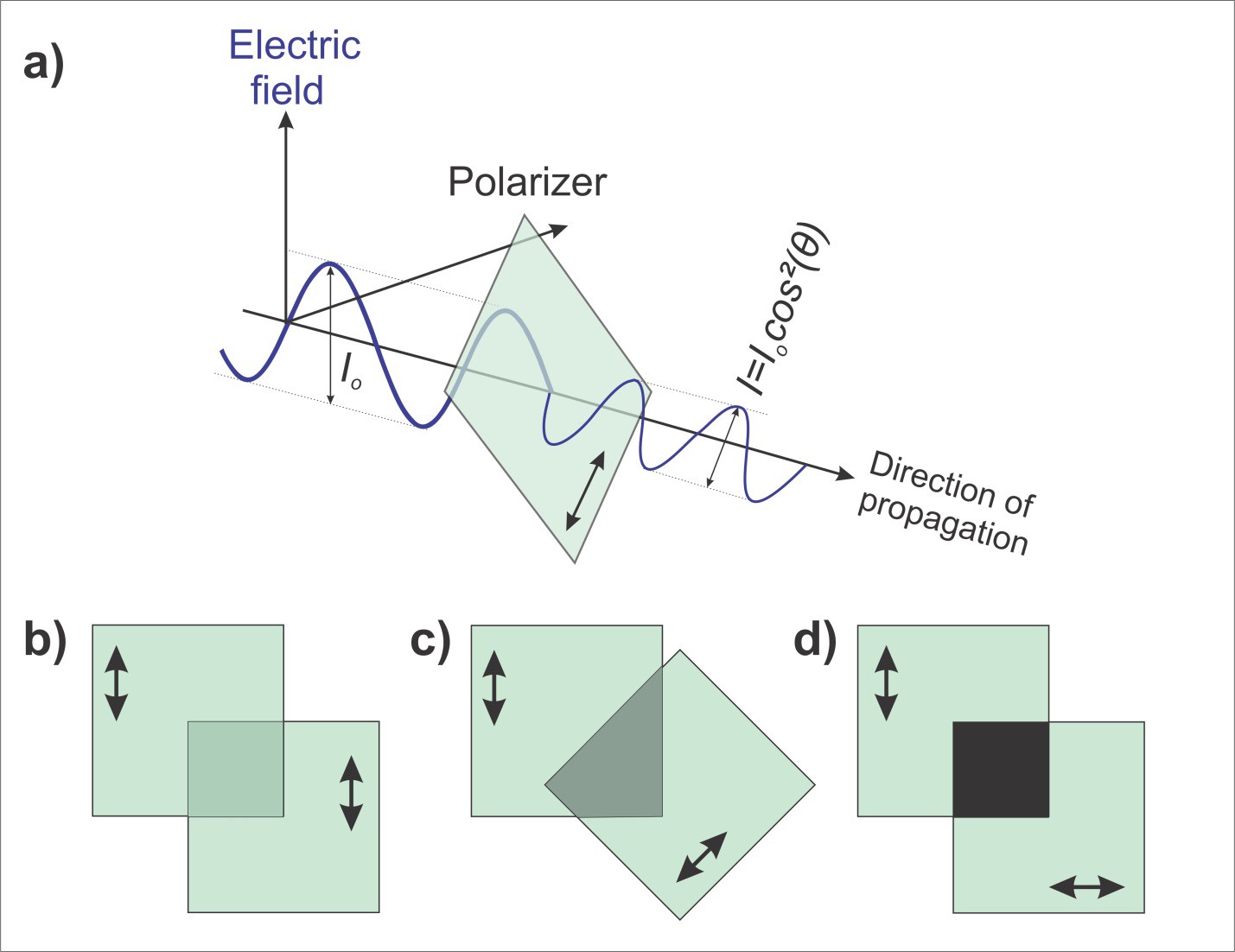
The amount of polarized light that passes through a polarizer depends on the angle between the polarized light’s axis and the polarizer’s main axis. a) The intensity of the light exiting the polarizer follows the cosine square of the angle between the light’s polarization axis and the polarizer’s main axis.With light going through two pieces of polarizer, minimum attenuation happens when the axes of polarization of the pieces of film are aligned (b).Attenuation increases as the angle between the axes increases (c) until a maximum attenuation occurs when the films are cross-polarized.
Maximum transmission will happen when the polarizers are aligned, while minimum transmission will take place with the polarizer orientations crossed. Half of the maximum intensity is observed at a rotation angle of 45⁰.
Besides linear polarization, light can also be circularly polarized.This type of polarization is obtained when light polarized at 45⁰ passes through a material that transmits light at different speeds depending on its polarity.Linear polarization is thus given a “twist” when one polarization component (e.g. the vertical component of the 45⁰ light) is retarded by ¼ of its wavelength with respect to the other component (e.g. the horizontal component).When exiting the retarder material, the vertical component is slowed down so that it is out of phase with the horizontal component. To an observer receiving this light, the electric field will appear to rotate rather than just oscillate up and down. Hence the term “circular” polarization. Circularly-polarized light can be polarized either clockwise (right-handed circular polarization or RHCP) or counterclockwise (left-handed circular polarization or LHCP).
 Circularly-polarized light. The convention is to define the sense of polarization as viewed by the receiver, so (a) represents the electric field vector as a function of time of right-handed, clockwise circularly polarized light, while (b) represents left-handed, clockwise circularly polarized light. Image credit: Anonymous via Wikimedia Commons
Circularly-polarized light. The convention is to define the sense of polarization as viewed by the receiver, so (a) represents the electric field vector as a function of time of right-handed, clockwise circularly polarized light, while (b) represents left-handed, clockwise circularly polarized light. Image credit: Anonymous via Wikimedia Commons
Circularly-polarized light is easy to produce, and is used extensively in 3D movie projection (e.g. the RealD digital stereoscopic projection system encodes one image in RHCP, and the other in LHCP).However, natural materials that circularly-polarize light are very scarce, so restricting the analysis of a scene to its linear polarization characteristics is appropriate for most applications.
DOLPI-Mech: A RasPi-based Classical Polarimetric Camera
In the full project's whitepaper available at http://www.prutchi.com/wp-content/uploads/2015/10/DOLPi-v5.0.pdf you can find the mathematical formalism behind the analysis of polarized light. For now, let me state that complete linear polarization state analysis can be performed on a scene from 3 individual images taken through a linear polarizer set at 0⁰, 45⁰, and 90⁰. In addition, the handedness of circular polarization can be obtained if an additional picture is obtained through a circular polarizer.
One simple way of obtaining the necessary images is to use a filter wheel. That is, a mechanically-rotated wheel that carries different filters in front of a camera. The paper shows the construction of DOLPi-Mech - a simple Raspberry Pi-based polarimetric imager with a mechanically-rotated cardboard filter wheel that holds 6 polarizer filters. Four of them are made of linear polarizer film set so to analyze the image at 0⁰, 90⁰, 45⁰, and -45⁰ when the selected filter is placed in front of the Raspberry Pi camera. The other two filters are circular polarizer films. One slot in the filter wheel is left blank to make it possible to take unfiltered snapshots. The filter wheel is rotated by a standard servo driven by an Adafruit Servo PWM HAT connected to a Raspberry Pi 2.
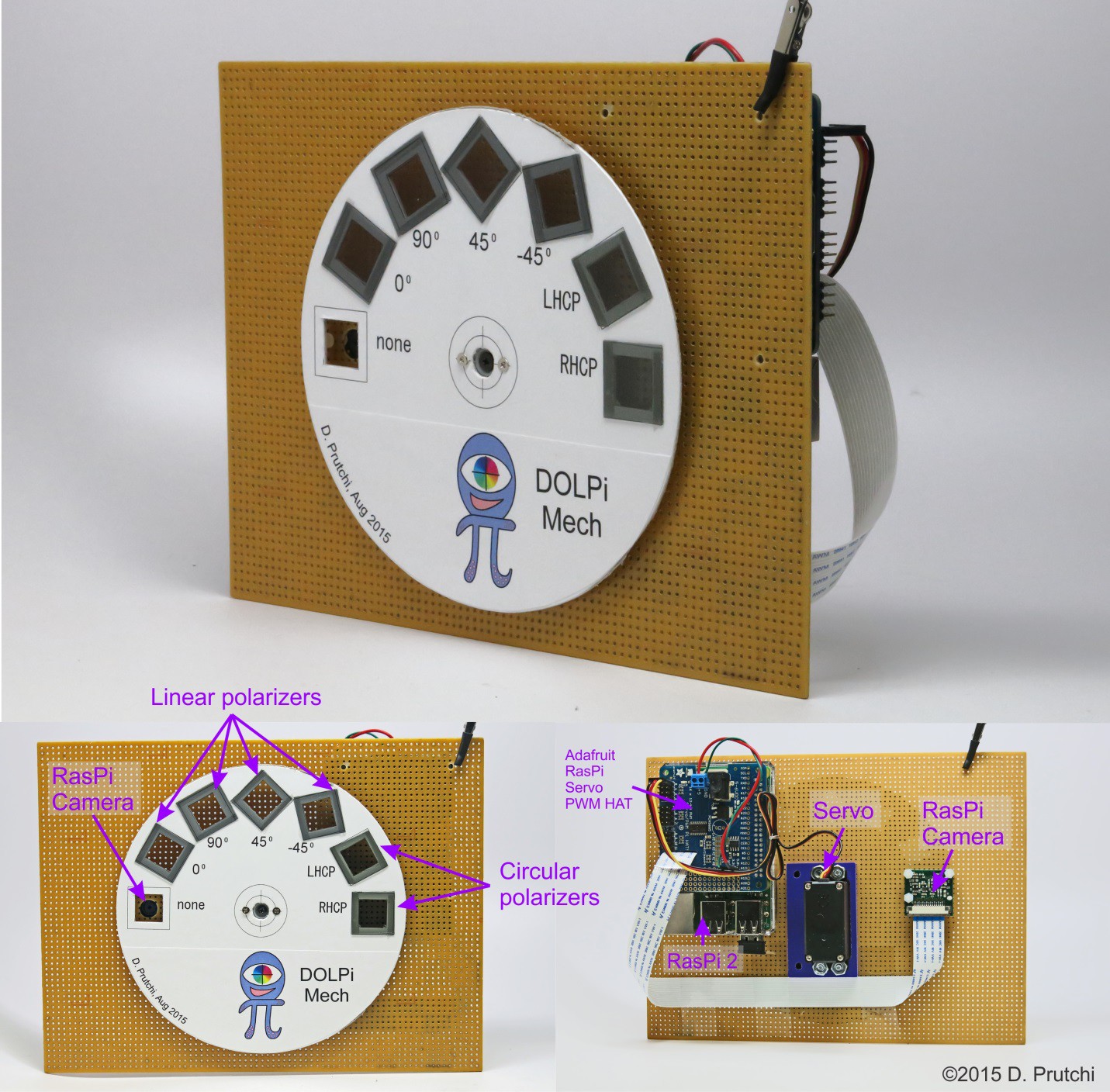
DOLPi-Mech is a simple polarimetric imager based on a mechanically-rotated cardboard filter wheel that holds 6 polarizer filters. Four of them are made of linear polarizer film set so to analyze the image at 0⁰, 90⁰, 45⁰, and -45⁰ when the selected filter is placed in front of the Raspberry Pi camera. The other two filters are circular polarizer films. One slot in the filter wheel is left blank to make it possible to take unfiltered snapshots. The filter wheel is rotated by a standard-size 180⁰ servo driven by an Adafruit Servo PWM HAT connected to a RasPi2.

This flowchart explains the simple software used to image with the DOLPi-MECH. After loading libraries and initializing the Raspberry Pi’s ports, the Raspberry camera is allowed to sample the scene for a few seconds to set its internal auto-exposure and then locking the exposure settings to keep consistency among images. The imaging loop consists of taking three grayscale images with the filter wheel selecting linear polarization filters set at 0⁰, 45⁰, and 90⁰, and then combining these pictures into a single color image that encodes polarization.
In the following figure, the sample target is made of polarizing film set at the angles shown in the picture. The two bottom squares are circular polarizers (one LHCP and the other RHCP, taken from RealD 3D movie glasses). We can’t tell the difference between the polarizer films because our vision is not sensitive to polarization, and neither is the RasPi’s camera sensor.
The colors in the right-side picture have nothing to do with the actual color of the object, but instead encode the Angle of Polarization. Pure gray tones in the polarimetric image mean that light is unpolarized. Some of the coloring pencils and other items in the background show in color because they partially polarize reflected light as a function of their material, texture, and angle of reflection.
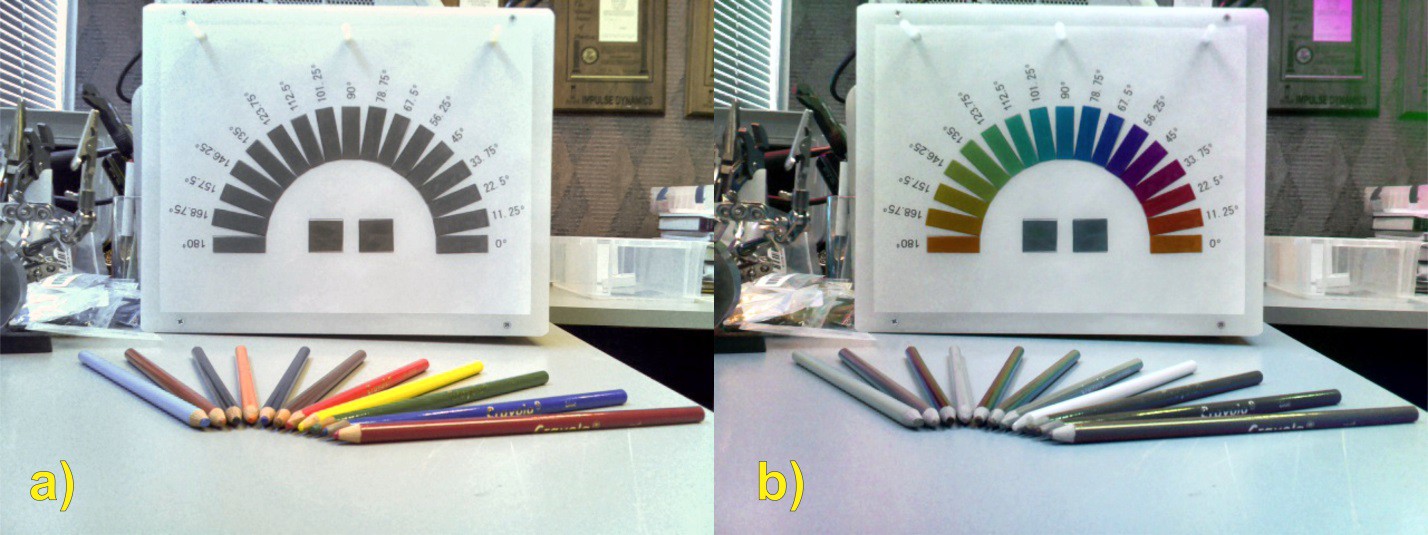
Sample image obtained with DOLPi-Mech and its Python code. (a) Unfiltered image (RasPi camera looking through open slot in filter wheel). (b) Picture taken by DOLPi-Mech by assigning the 0⁰ grayscale image to the Red channel of the output image, the 90⁰ grayscale to Blue, and the 45⁰ grayscale to Green. The colors in (b) have nothing to do with the actual color of the object, but instead encode the light’s Angle of Polarization.
DOLPi’s Electro-Optic Polarization Modulator
Mechanically-rotating a polarization analyzer (or a filter wheel as in DOLPi-Mech) is slow, which is not amenable to polarimetric video imaging.For this reason, the heart of the DOLPi camera is an Electro-Optic (EO) polarization modulator. This assembly, which consists of two liquid-crystal panels and a linear polarizer film, selectively passes light at different polarization angles under software control.
The liquid crystal panel used for the DOLPi camera is harvested from a low-cost auto-darkening welding mask filter. These are similar in construction to an LCD display, where the whole filter is a single gigantic “pixel”. In its intended use, the auto-darkening filter allows the user to see through the filter while setting up the pieces to be welded, but as soon as light sensors detect the welding arc, the filter turns dark to protect the welder’s eyes.

The liquid crystal panel (LCP) for the DOLPi camera is harvested from a low-cost auto-darkening welder mask filter.I purchased these units for $9 each on eBay®.The box in which the filter came indicates that it is manufactured by “Mask” in China.Their website is www.auto-mask.com. b) The front side of the filter’s enclosure (facing the pieces being welded) exposes the UV/IR filter that preceded the electrically-controlled light shutter, two photovoltaic panels (“solar cells”), and two light sensors used by the circuit to detect the presence of a welding arc.
The electrically-controlled light shutter in the auto-darkening filter is based on a liquid crystal panel (LCP) sandwiched between two polarizers. The liquid crystal panel is constructed from two glass windows separated a few microns apart. Each window is coated with transparent conductive Indium Tin Oxide (ITO) that will serves as an electrode. Depending on the type of liquid crystal used, a thin dielectric layer may then applied over the ITO and gently rubbed to provide for liquid crystal molecular alignment. The cavity is then filled with birefringent nematic liquid crystal material Lastly, electrical contacts are attached and the panel is environmentally sealed.
As shown in the following figure, with no bias voltage applied between the electrodes, the liquid crystal molecules are guided by the scratch lines rubbed to form the alignment layer, and thus align parallel to the windows. In this orientation the liquid crystal panel shifts the polarization of incoming light by (approximately) 90⁰.However, when 5V are applied to the panel, the liquid crystal molecules align with the electric field and tip perpendicular to the windows. In this state, the polarization of incoming light remains largely unchanged (i.e. polarization shift is approximately 0⁰).

Without a voltage applied to the LCP, the liquid crystal molecules have an ordered orientation, which together with the stretched shape of the molecules causes them to shift the polarization of light by 90⁰ (a). When an electric field is applied, the molecules align to the field and the polarization shift depends on the tilting of the liquid crystal molecules. Beyond some voltage, the LCP introduces almost no polarization tilt (b).
The following figure shows how the electrically-controlled light shutter in the auto-darkening filter works. Light from the scene is polarized by a first polarizer film. In the absence of the LCP, the polarized light would not be able to go through the second polarizer because it is set orthogonally with respect to the first polarizer. However, when the unbiased LCP is placed in the middle, it rotates the polarization of the light passing through the first polarizer by 90⁰ such that it can go through the second polarizer.However, to darken the filter, the mask’s control circuit applies >5V to the LCP, which causes light going through it to maintain the polarization set by the first polarizer, thus preventing the light to go through the second polarizer and into the welder’s eyes.

The core component of the auto-darkening welding mask filter is a liquid crystal panel (LCP) sandwiched between two crossed polarizers. a)In the absence of an electric field, the LCP turns the polarization by 90⁰, so light can go through the second polarizer unimpeded. b)When 5V are applied across the LCP, polarization is conserved, so light cannot pass through the second polarizer. c)Transmission curve for the filtered, electrically-controlled light attenuator of the auto-darkening welding mask filter. Without the UV/IR filter (purple glass cover) the transmission at 0V is around 30% and drops to around 1% at 5V.
The DOLPi Camera
The welding mask’s LCP can be made to rotate polarizationto values between its two extremes at 0⁰ and 90⁰. (Note: This statement is not strictly true.The retardation process performed by a LCP is not the same as rotation of linear polarization. In reality, the LCP driven half-way acts as a quarter-wave plate, and hence the strict interpretation of the analysis at this level is for circular polarization rather than linear polarization at 45⁰. I didn’t want to go into a thorough explanation of polarization optics to keep the project accessible, but based on my experiments, I’m convinced that DOLPi’s “45⁰ image” indeed contains a dominant 45⁰ component when observing linearly polarized light. However, as we’ll see later, DOLPi incorrectly understands circularly-polarized light as a 45⁰ signal.)
Although it is possible to find a voltage that will set the LCP to rotate light’s polarization by around 45⁰, changes in the liquid crystal take place with time, so the polarization state will shift with complex, interacting time constants that are dependent on temperature, age, and other factors. For this reason, the drive amplitude to achieve pseudo-45⁰ rotation of polarization needs to be periodically recalibrated.
The following figure shows a block diagram for the DOLPi camera, which is my solution to acquiring the three pictures (analyzed at 0⁰, 45⁰, and 90⁰) to perform complete linear polarization imaging of a scene. The imaging element is the official Raspberry Pi camera connected directly to a Raspberry Pi 2’s dedicated camera connector. The camera views the scene through the VCPA hacked from an auto-darkening welding mask filter as discussed above. In my first prototype, I chose to tilt the VCPA by 45⁰ with respect to the camera’s horizon because the polarizer film used in the mask is oriented at this angle, so tilting reorients it vertically with respect to the camera. However, identical results are possible when mounting the LCPA horizontally, vertically, or at 45⁰ by defining the correct frame of reference through software.
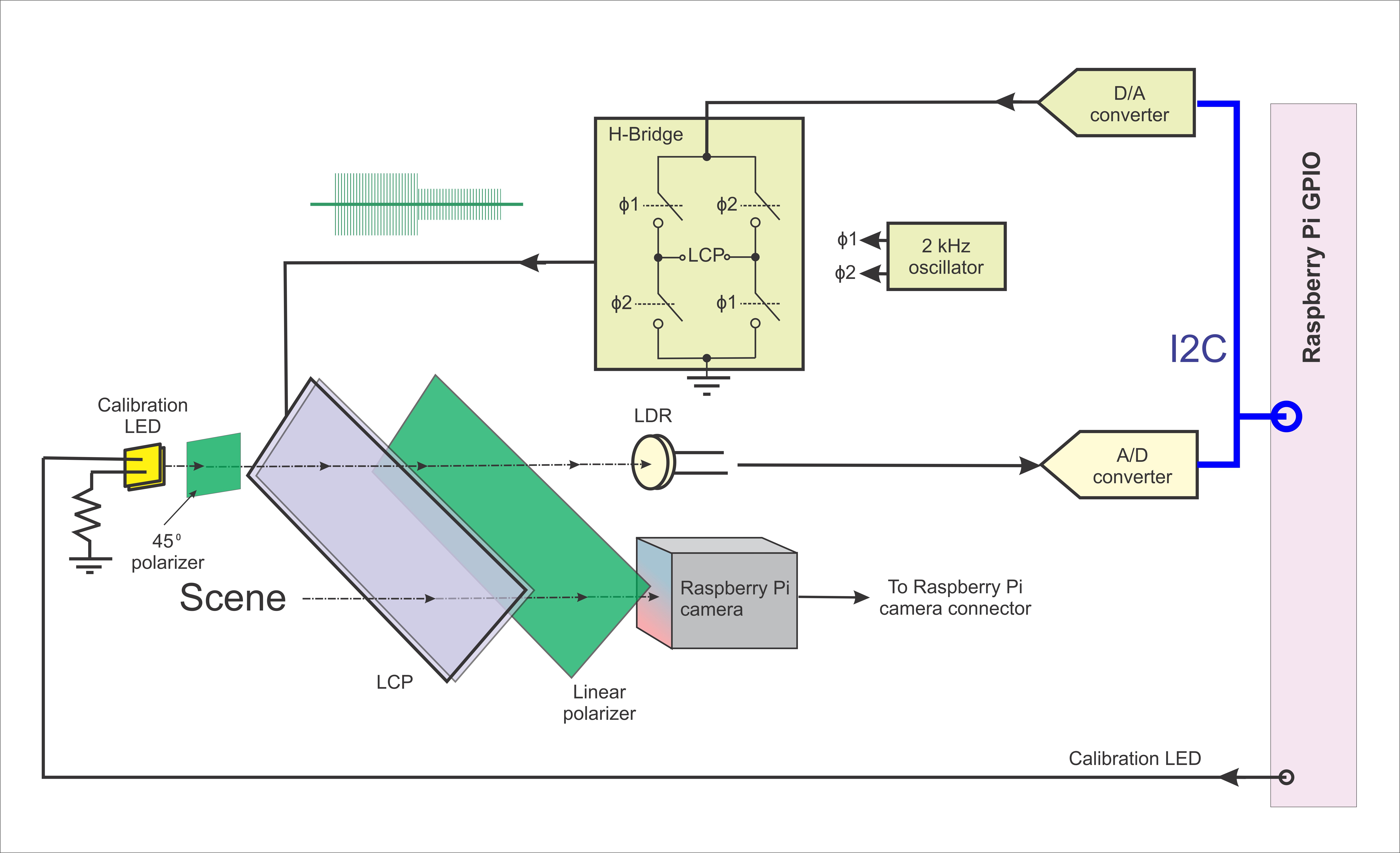
Block diagram of the DOLPi camera.The VCPA is AC-driven at 2kHz. The drive amplitude is controlled from software via a D/A converter. The drive amplitude for 45⁰ polarization shift is determined by an auto-calibration circuit consisting of an A/D converter that measures the intensity of 45⁰ polarized light that goes through the VCPA as a function of D/A output.
The AC driver and auto-calibration circuit for DOLPi is shown in the following figure.

I built the DOLPi prototype on a piece of perfboard which not only serves as the substrate for the AC driver circuit, but also acts as a support platform for all other components.

Productized version of the electro-optic DOLPi polarimetric camera using Raspberry Pi Foundation’s new touchscreen display and a modified commercially-available enclosure.
The flowchart for the simplest automatic DOLPi software is shown in the following figure. After loading required libraries and initializing the Raspberry Pi’s ports, the device runs the auto-calibration procedure by sweeping through LCP drive amplitudes between 0V and 10Vp-p while measuring the intensity of 45⁰-polarized light going through the VCPA.The DAC setting at maximum transmission is stored for use in taking frames at 45⁰.
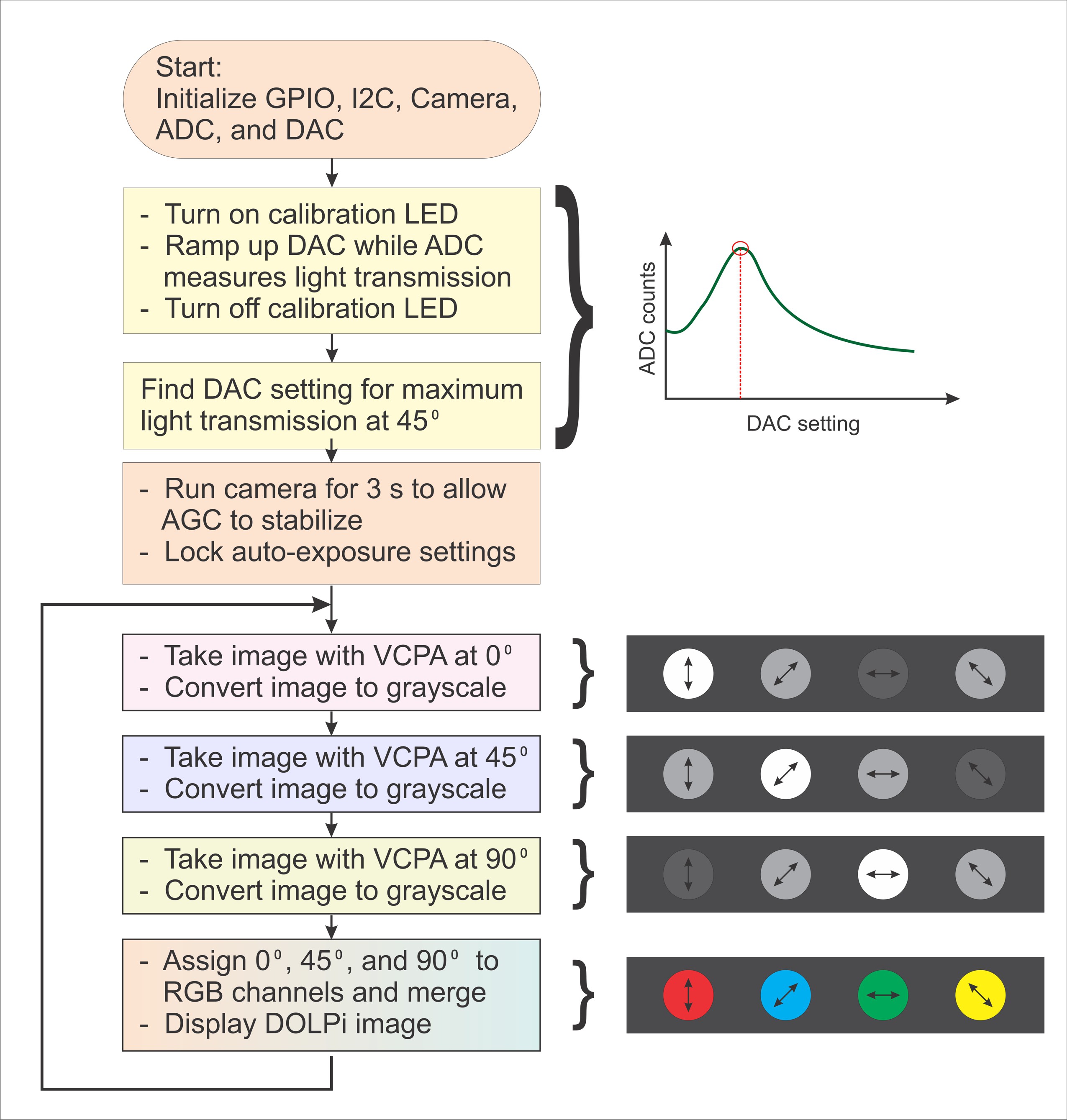
This flowchart explains the simple software used to auto-calibrate and image with the DOLPi camera.After loading libraries and initializing the Raspberry Pi’s ports, the device runs the auto-calibration procedure by sweeping through LCP drive amplitudes between 0V and 10Vp-p while measuring the intensity of 45⁰-polarized light going through the VCPA. The DAC setting at maximum transmission is stored for use in taking frames at 45⁰. The Raspberry camera is then allowed to sample the scene for a few seconds to set its internal auto-exposure and then locking the exposure settings to keep consistency among images.The imaging loop consists of taking three grayscale images with the VCPA set at 0⁰, 45⁰, and 90⁰, and then combining these pictures into a single color image that encodes polarization.

The autocalibration procedure searches for the drive point of maximum light transmission through the VCPA illuminated by light polarized at 45⁰.The x-axis is the RMS VCPA drive voltage (in DAC counts).
Visualizing polarization
Note: A more thorough description of the polarimetric visualization process is available in the project's whitepaper at: http://www.prutchi.com/wp-content/uploads/2015/10/DOLPi-v5.0.pdf
Assigning the images captured with the VCPA set at 0⁰, 45⁰, and 90⁰ to the RGB color channels is one simple way of visualizing polarization. Another popular way of presenting polarization information is by recognizing that the three main polarization components – polarization intensity, Degree of Linear Polarization, and Angle of Polarization - are analogous to the color components of brightness, saturation, and hue.The polarization parameters merged into the HSV (Hue, Saturation, Value) color space is shown in the following figure:
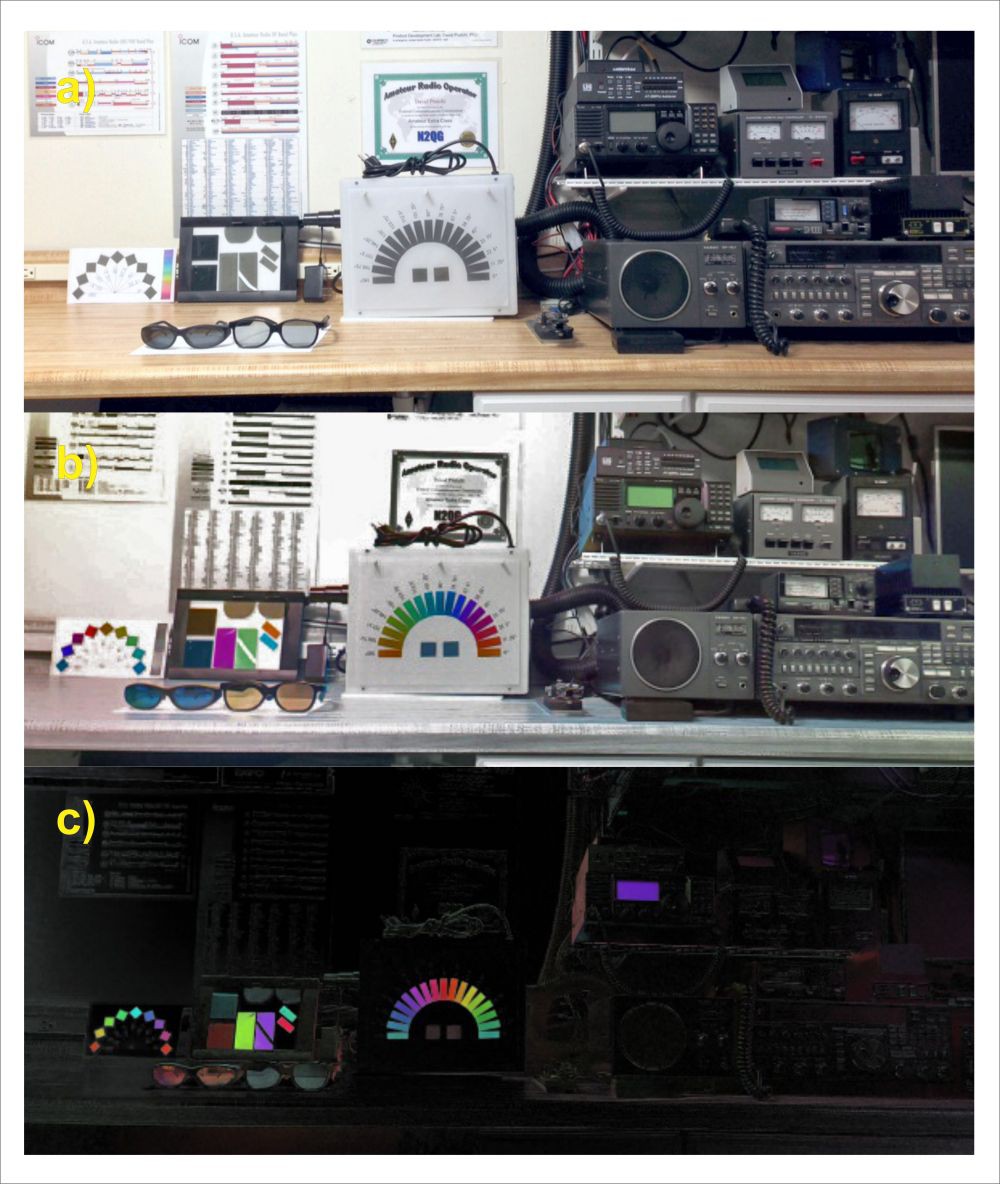
This figure illustrates polarimetric imaging with some real images. Here, I placed some polarization targets (none are back-illuminated) next to my ham radio station. Nothing specific can be told about the polarizers from the visible image in (a). However, the RGB (b) adds color to encode the angle of polarization of polarized light, while removes all color from non-polarized light (unpolarized reflections show in grayscale). The HSV image (c) goes one step further, showing only polarized light. The purple square to the right of the image is the reflection of the LCD in my HF transceiver.
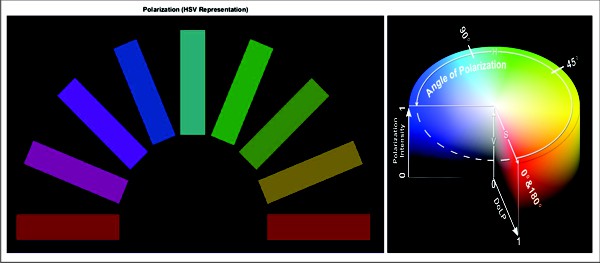
This figure explains the HSV representation of polarization parameters (DoLP, AoP, and Polarization Intensity), where the figure at the right is the colormap for the HSV image.
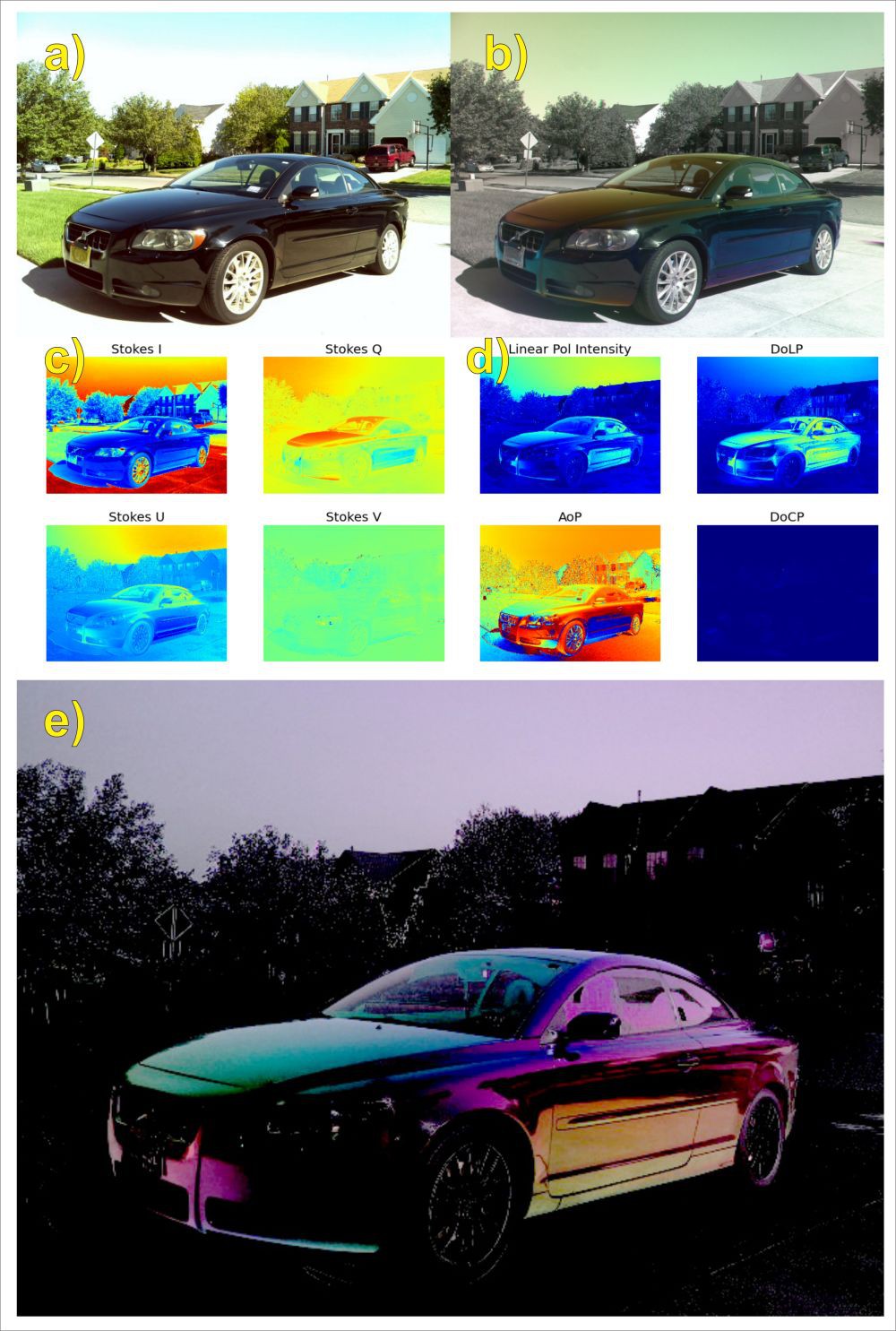
Real-world polarimetric imaging using DOLPi-MECH. a) Normal visible image of the scene.b) RGB-encoded polarization image.Colors in this image are not related to the actual color (wavelength) of the light.Instead, colors relate to the angle of linear polarization. c) Stokes parameters calculated by the DOLPi software. d) Polarimetric parameters calculated by the DOLPi software. e) HSV-encoded polarimetric image clearly shows surfaces that reflect polarized light. Please note the absence of circularly-polarized light in this image, which is typical of the vast majority of outdoors scenes.
Polarized Light in the Environment
Non-polarized light becomes polarized when it is reflected by a nonmetallic surface. The degree of polarization depends on the angle at which the light hits the surface, as well as on the type of reflective material. As shown in the following figure, water, snow fields, and asphalt roads reflect the Sun’s light with very strong horizontal polarization (i.e. parallel to the reflective surface).
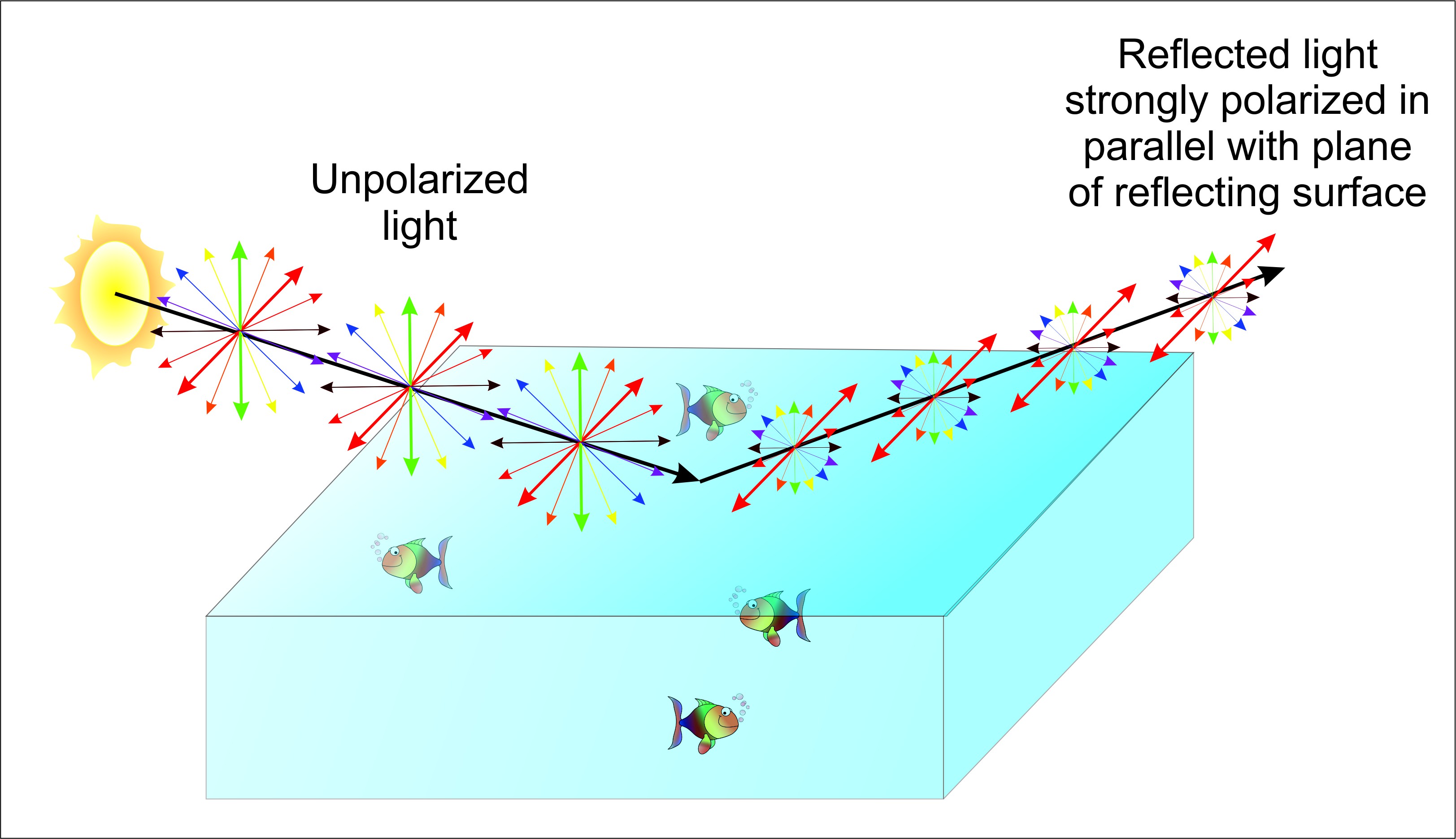 Non-polarized light becomes polarized when it is reflected by a nonmetallic surface. The degree of polarization depends on the angle at which the light hits the surface, as well as on the type of reflective material. Water, snow fields, and asphalt roads reflect the Sun’s light with very strong horizontal polarization. Vertically-polarized sunglasses thus cut the glare produced by horizontally-polarized reflections
Non-polarized light becomes polarized when it is reflected by a nonmetallic surface. The degree of polarization depends on the angle at which the light hits the surface, as well as on the type of reflective material. Water, snow fields, and asphalt roads reflect the Sun’s light with very strong horizontal polarization. Vertically-polarized sunglasses thus cut the glare produced by horizontally-polarized reflections
Many aquatic insects use their polarization-sensitive vision to locate ponds. For example, insects that lay eggs in water find and select egg-laying sites based on the intensity of polarization from reflective water surfaces. Unfortunately, many human-made objects can reflect horizontally polarized light so strongly that they appear to aquatic insects to be bodies of water. Some – like solar panels – reflect light with such high level of horizontal polarization (close to 100%) that they look to aquatic insects as far superior breeding grounds than pond water (which reflects light with a degree of polarization of around 30 to 70%), becoming ecological death traps to these organisms[Horvath et al, 2010].As a consequence, or maybe even through the same polarization-based location mechanism, bird populations may be affected by solar farms because the disruption of a bird’s natural patterns of behavior may lead to disorientation and increased energy use [BirdLife, 2015].
NASA has started to mimic insect vision and experiment with polarimetric imaging to locate ponds from satellites and high-flying aircraft.You may think that this is a trivial problem, but in reality classical multispectral imaging often confuses shallow, oxygen-rich ponds with vegetation fields. This is because such ponds serve as good breeding grounds for algae that make their surface green. However, as shown in the following figure, the water surface reflects highly polarized light even in the presence of the algae.
 Images obtained by the Jet Propulsion Laboratory’s Airborne Multispectral Polarimetric Imager (AirMSPI) from NASA’s ER-2 high altitude aircraft flying over the California Central Valley.Left panel shows a normal visible-range image, while the panel on the right shows DoLP at 470, 660, and 865 nm wavelengths.The most prominent DoLP features are the bright white regions in the far center left of the image.While these look like fields in the true color image, they are actually holding ponds for a wastewater treatment plant.
Images obtained by the Jet Propulsion Laboratory’s Airborne Multispectral Polarimetric Imager (AirMSPI) from NASA’s ER-2 high altitude aircraft flying over the California Central Valley.Left panel shows a normal visible-range image, while the panel on the right shows DoLP at 470, 660, and 865 nm wavelengths.The most prominent DoLP features are the bright white regions in the far center left of the image.While these look like fields in the true color image, they are actually holding ponds for a wastewater treatment plant.
Another natural source of polarized light is scattering of sunlight in the atmosphere.The exact mechanism is outside the scope of this article, but suffice it to say that sunlight that is scattered backwards (or forward) by the atmosphere remains unpolarized, while light scattered at 90⁰ degrees from the Sun’s position becomes linearly polarized, while light scattered at intermediate angles is only partially polarized. As shown in the following figure, the polarization vectors in the sky are all oriented along parallel circles centered on the Sun's position. Being able to see the distribution of polarization angles can be used as an orientation cue. In fact, sky polarization patterns are used by many insects for navigation. For example, honeybees use celestial polarization to move between the hive and foraging locations.Salmons are thought to have similar capabilities to orient themselves based on the sky’s polarization as seen underwater.
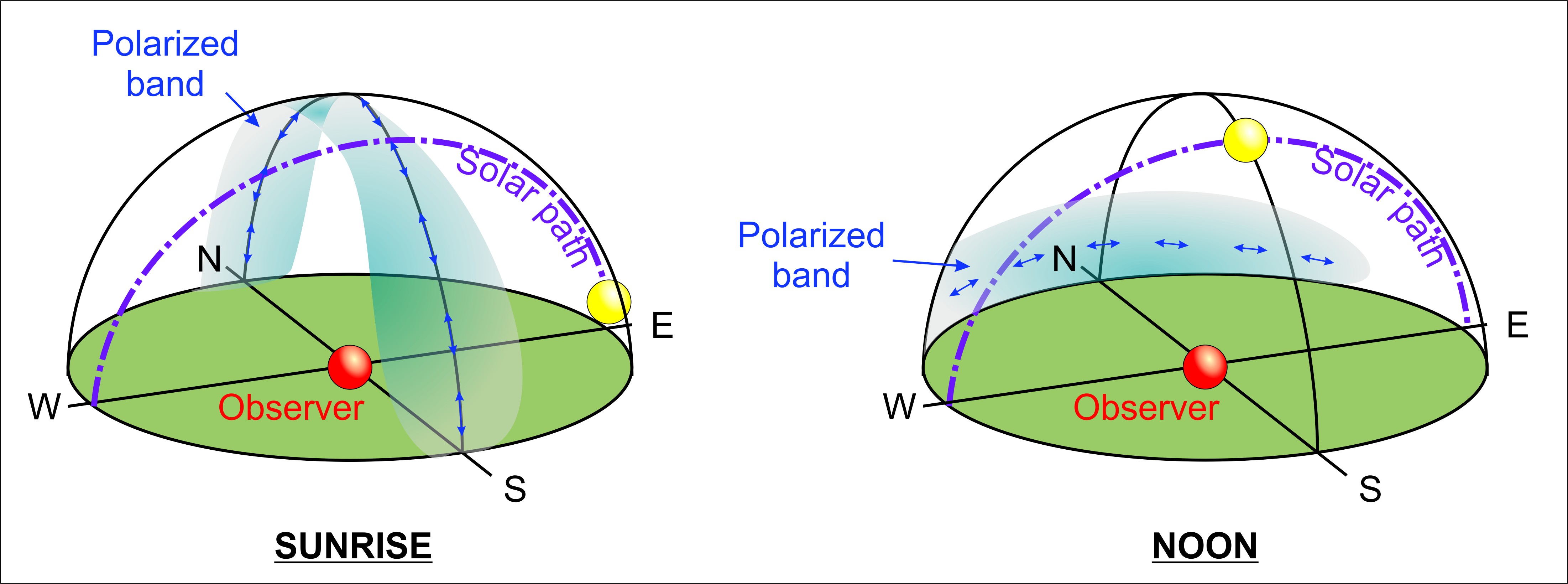
The sky is polarized tangential to a circle centered on the Sun.A band of maximum polarization occurs 90⁰ from the Sun. At sunrise and sunset, the sky is maximally polarized along the meridian, and thus vertically-polarized at the horizon.On the other hand, at noon the band of maximum polarization is horizontally polarized along the horizon.Many insects use sky polarization patterns for navigation. Honeybees use celestial polarization to move between the hive and foraging locations.
So… What about the Cloaked UFOs?
I have never seen a UFO, and don’t know anyone who claims to have seen one either. In addition, I am not aware of any compelling evidence that we are being visited by extraterrestrial beings, so I remain skeptical. However, it is fun to imagine how massive alien (or military) craft could be made to fly in our skies without being seen. Maybe the craft could be rendered transparent like Wonder Woman's airplane? Maybe it could bend or reflect the light around it so that it is cloaked within a bubble of invisibility? Maybe it could use an active cloaking screen that paints an image of the background on its surface (e.g. electro-optical adaptive camouflage [Schowengerdt, 1994])?
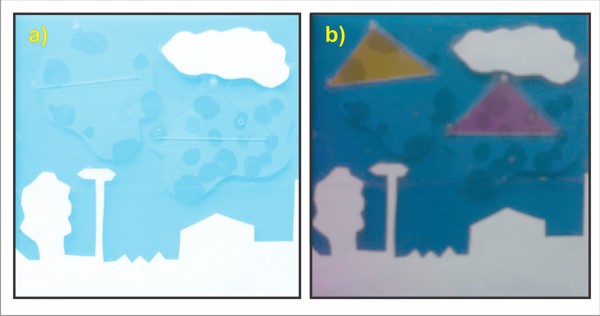
It’s fun to think how UFOs and secret military aircraft could be flying cloaked right above us without being noticed (a), but polarimetric imaging could possibly work against artificial cloaking devices because there is almost always a polarization change whenever light interacts with matter (b).The polarizing sky is simulated by a linear polarizer sheet, while the triangular “UFOs” are cut from transparent retarder films. The image on the left was snapped with my iPad, while the one on the right is the DOLPi RGB preview image.
We don’t have to go extraterrestrial to find examples of these cloaking methods. Just go into the ocean and you’ll find dozens of species that camouflage themselves through transparency and mirror reflection. However, these cloaking strategies can be defeated by animals that have evolved polarization-sensitive vision, and the same could possibly work against artificial cloaking devices. As a matter of fact, polarization cues are so important underwater that evolution has given some animals – like cuttlefish – polarization-sensitive instead of color-sensitive vision [Les, 2012].

Cuttlefish are color-blind, but have polarization-sensitive vision with a resolution of about 1⁰.They are often referred to as the "chameleons of the sea" because of their remarkable ability to rapidly alter their skin color and pattern - including polarization - to camouflage themselves, to scare potential predators, and to communicate with other cuttlefish.Image credit: "Cuttlefish @ Oceanário de Lisboa" by David Sim via Wikimedia Commons.
Transparent animals are never completely transparent, but their refraction index is sufficiently well matched to that of water that it is difficult to see from a distance. However, transparent tissues modify the polarization of light, either by increasing or decreasing its polarization state, such that they will contrast against their background when seen through polarization-sensitive eyes. For example, polarization-sensitive squid can detect zooplankton prey at 70% greater distance under partially polarized lighting than under nonpolarized lighting.
In the same way, cancerous cells reflect and scatter light with different polarization characteristics than those of healthy cells. Just as with color, polarization differences can provide additional contrast cues to detect malignant cells. This technique is being investigated by a number of researchers [Antonelli et al., 2009, Manikova et al, 2013], and I believe that DOLPi could enable the development of a cheap and effective “smart mirror” for at-home skin cancer screening.
Along similar lines, polarimetry has been shown to provide advantages in early detection of structural changes in the eye’s retina, which would permit the development of non-contact techniques for early diagnosis of glaucoma, which is a leading cause for visual impairment [DeHoog et al., 2009; Wang et al., 2015].
Polarimetric imaging is an excellent contrast-enhancing technique because its information supplements the knowledge that can be derived from intensity and color imaging. Spectral characteristics (color) depend largely on the materials that make up the objects in a scene. However, the polarization properties depend strongly on the microscopic shape of a reflective surface (roughness) and its orientation. As such, spectral and polarization information supplement each other by contributing independent features for the detection and characterization of camouflaged objects or those hidden in a cluttered environment. Furthermore, man-made objects often reflect light with some degree of polarization when they incorporate non-metallic surfaces such as glass, plastic, paints, and rubbers. Since most natural backgrounds do not polarize light, man-made materials are highlighted by color in DOLPi images. Neither camouflage nor moderate foliage escape a polarimetric imager, making it possible to develop new methods for humanitarian detection and clearance of land mines [de Jong and Schavemaker, 2007; El-Saba et al, 2008].
I believe that landmine detection for humanitarian demining is one of the best and most promising applications of polarimetric imaging with DOLPi, and one that can save countless young lives in countries that have been ravaged by war.
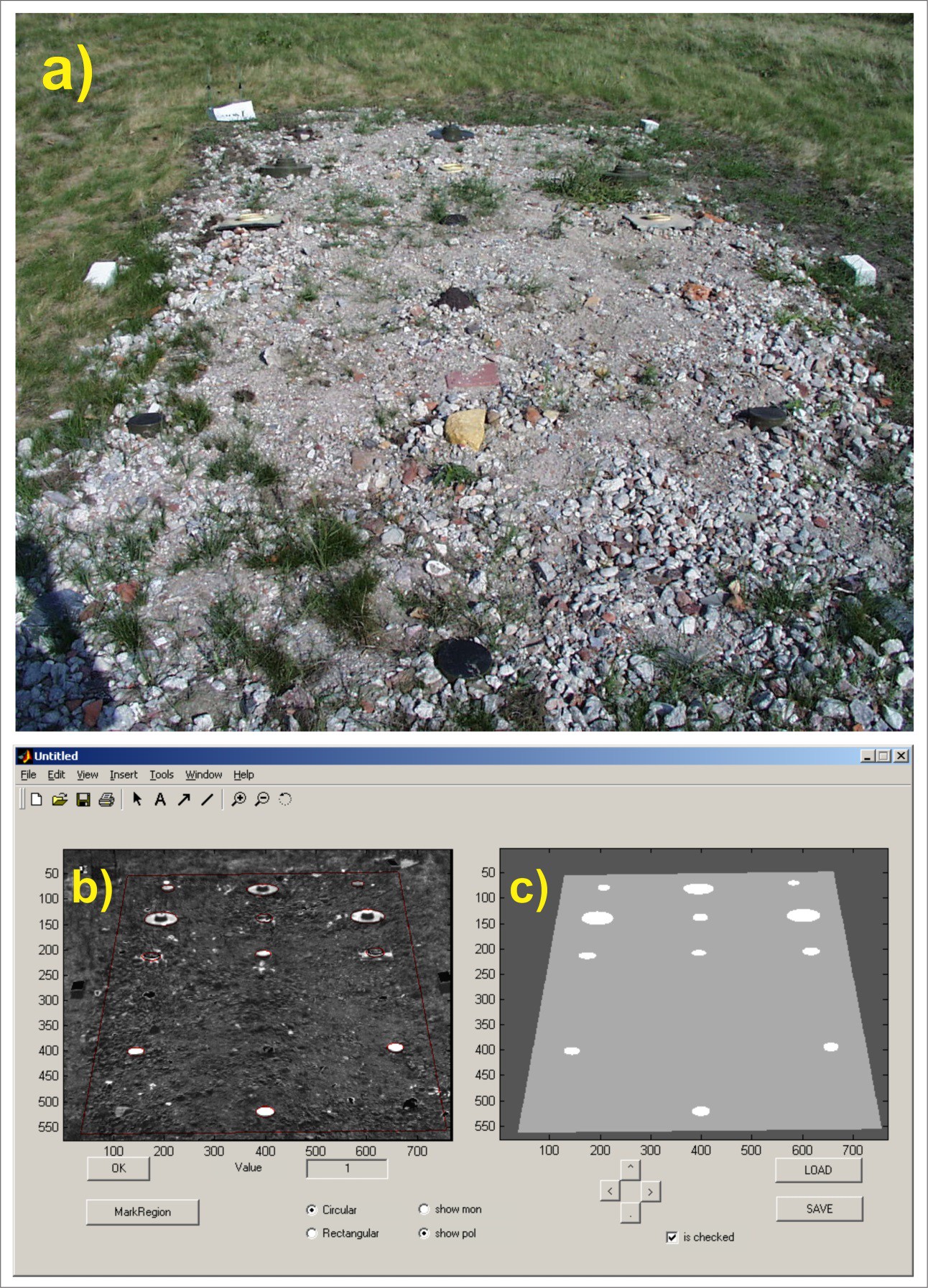 The detection of land mines for humanitarian demining is one of the most important potential applications for DOLPi.I integrated this figure using images that were kindly supplied by TNO scientists Drs. Wim de Jong and John Schavemaker to exemplify their polarimetric imaging results of detecting replicas of four different types of mines that appear frequently in mine-afflicted countries. a)Visible image in a cluttered field. b) The mines can be clearly seen in the polarimetric image. c) Image showing the true location of land mines.Some of the clutter in the field reflects highly polarized light and may thus give some false positives to automatic software. Image credit: Images used with the author’s permission from de Jong W, Schavemaker J, “Using Polarization Features of Visible Light for Automatic Landmine Detection” in Physics of Automatic Target Recognition - Advanced Sciences and Technologies for Security Applications, 3,73-90, 2007.
The detection of land mines for humanitarian demining is one of the most important potential applications for DOLPi.I integrated this figure using images that were kindly supplied by TNO scientists Drs. Wim de Jong and John Schavemaker to exemplify their polarimetric imaging results of detecting replicas of four different types of mines that appear frequently in mine-afflicted countries. a)Visible image in a cluttered field. b) The mines can be clearly seen in the polarimetric image. c) Image showing the true location of land mines.Some of the clutter in the field reflects highly polarized light and may thus give some false positives to automatic software. Image credit: Images used with the author’s permission from de Jong W, Schavemaker J, “Using Polarization Features of Visible Light for Automatic Landmine Detection” in Physics of Automatic Target Recognition - Advanced Sciences and Technologies for Security Applications, 3,73-90, 2007.
Polarimetric imaging with DOLPi can thus be used for a large number of image enhancement tasks such as glare reduction, haze removal, background removal, and contrast enhancement. These are highly valuable for forensic work, industrial and environmental monitoring, microscopic investigation of tissues and plastics, and autonomous vehicle vision just to name a few.
Saving the World
DOLPi will be there to save the day if Wonder Woman ever turns into a supervillain bent on destroying the world with her transparent jet (which is transparent to intensity and color, but which we may imagine shifts polarization) .Barring that scenario, DOLPi will probably serve more as a low-cost foundation for the development of applications based on polarization-sensitive imaging and machine vision.However, the disruptive power of this technology is truly awesome!
The use of polarimetric imaging for skin cancer detection was discussed above.Developing a low-cost self-examination camera to screen for skin cancers would have an enormous impact on world health.Just consider that according to the American Academy of Dermatology, one in five Americans will develop skin cancer in the course of a lifetime! A screening technique based on DOLPi would dramatically change the effect of this disease since basal cell and squamous cell carcinomas, the two most common forms of skin cancer, are highly curable if detected early and treated properly.
Polarimetric imaging has also started to be used for aircraft- and satellite-based characterization of atmospheric aerosol particles – a worldwide problem of significant impact. In fact, particle size, chemical composition, and shape can only be measured by including polarization information into a satellite’s imaging capabilities [Snik et al., 2014]. Unfortunately, satellite observations only show what can be seen from above, and not what hides below layers of clouds and pollution.
DOLPi opens up the field of polarimetric imaging to the citizen scientist, enabling the development of techniques for remote sensing of vast swaths of atmosphere [Kreuter et al., 2013] to detect and characterize pollution and volcanic ash, giving the public unfiltered access to information about the nature and sources of hazardous air contaminants.
DOLPi also enables the development of low-cost tools for real-time monitoring of volcanic emissions, providing advanced data to populations at risk, as well as to local airports and air traffic such that appropriate warnings can be issued to those in harm’s way. With a more strategic view, DOLPi gives researchers and enthusiast scientists the possibility of developing networks of low-cost sensors to measure atmospheric aerosol scattering and absorption properties that at are presently the principal source of uncertainty in climate modeling.
Lastly, I would like to reiterate the enormous impact that DOLPi or DOLPi-MECH can make in humanitarian demining efforts. Landmines and unexploded ordinance pose a threat in nearly 80 countries around the world. Most at risk are children playing in the field and displaced civilians reconstructing their communities after armed conflict. Here, the broad availability and low cost of the components required to build a DOLPi camera make it an ideal tool for use to rid the world of landmines and unexploded ordinance that are threatening civilian lives. Eliminating landmine casualties among returning refugees will give hope those who have endured the cruelty of war, and hence enhance the political and economic stability of those countries affected by landmines; and ultimately to promote worldwide peace and prosperity.
It is my hope that DOLPi will introduce fellow hackers and engineers to the awesome power of polarimetric imaging and inspire the development of breakthrough applications ranging from environmental monitoring and medical diagnostics, to security and antiterrorism applications.
A complete project description including detailed construction instructions and Python code is available in pdf format at: http://www.diyphysics.com/wp-content/uploads/2015/10/DOLPi_Polarimetric_Camera_D_Prutchi_2015_v5.pdf
References
Antonelli MR, Pierangelo A, Novikova T, DeMartino A, “Polarimetric Imaging of Human Tissue for Cancer Diagnostics: Experiment and Monte Carlo Modeling”, http://www.biop.dk/biophotonics09/Poster/Antonelli_NewSummary.pdf, 2009.
BirdLife International, “Migratory Soaring Birds Project Solar Energy Guidance V.1”, http://migratorysoaringbirds.undp.birdlife.org/sites/default/files/factsheet%20Solar%20Developer%20v1H.pdf, 2015.
Bossa Nova Technologies, SAMBA Camera Brochure, 2010.Available at: http://www.bossanovatech.com/Brochures/SAMBA camera - Brochure 2010.pdf
Bushman BB, Object Detector, U.S. Patent 5,404,225, Apr. 4, 1995. Available at: https://docs.google.com/viewer?url=patentimages.storage.googleapis.com/pdfs/US5404225.pdf
DeHoog E, Luo H, Oka K, Dereniak E, Schwiegerling J, “Snapshot Polarimeter Fundus Camera”, Applied Optics, 48(9), 1663–1667, 2009.Available at: http://www.ncbi.nlm.nih.gov/pmc/articles/PMC2853936/pdf/nihms183550.pdf
deJong W, Schavemaker J, “Using Polarization Features of Visible Light for Automatic Landmine Detection” in Physics of Automatic Target Recognition - Advanced Sciences and Technologies for Security Applications, 3,73-90, 2007. Available at: http://publications.tno.nl/publication/102398/ckt8Xu/jong-2007-using.pdf
El-Saba A, Bezuayehu T,"Higher Probability of Detection of Subsurface Land Mines with a Single Sensor using Multiple Polarized and Unpolarized Image Fusion”, in Polarization: Measurement, Analysis, and Remote Sensing VIII, edited by Chenault, David B.; Goldstein, Dennis H., Proceedings of the SPIE, 6972, 2008.
Horváth G, Blahó M, Egri A, Kriska G, Seres I, Robertson B, “Reducing the Maladaptive Attractiveness of Solar Panels to Polarotactic Insects”, Conservation Biology, 24(6), 1644-1653, 2010.
Horváth G, Barta A, Pomozi I, Suhai B, Hegedüs R, Åkesson S, Meyer-Rochow B, Wehner R, “On the Trail of Vikings with Polarized Skylight: Experimental Study of the Atmospheric Optical Prerequisites Allowing Polarimetric Navigation by Viking Seafarers”, Phil. Trans. R. Soc. B, 366, 772–782, 2011. Available at: http://rstb.royalsocietypublishing.org/content/royptb/366/1565/772.full.pdf
Jaulin A, Bigué L, “High Speed Partial Stokes Imaging using a Ferroelectric Liquid Crystal Modulator”, Journal of the European Optical Society - Rapid publications, 3, 2008 Available at: http://www.jeos.org/index.php/jeos_rp/article/view/08019
Bigué L, Ambs A, Jaulin A, Foulonneau A, Gendre L, Marconnet P, Imaging Liquid Crystal Polarimeters, 2008.Presentation slides available at: http://www.polarisation.eu/projectdir/Leiden_Bigue2.pdf
Klehm O, Ihrke I, Restrepo J,Manakov A, Hegeds R, PCT Patent Application WO2014124982 A1, Plenoptic Imaging Device, 2014. Available at: https://www.google.com/patents/WO2014124982A1?cl=en&dq=WO2014124982&hl=en&sa=X&ved=0CBwQ6AEwAGoVChMI45yz1ov-xwIVRJoeCh0OKQtF
Kreuter A, Blumthaler M, “Feasibility of Polarized All-Sky Imaging for Aerosol Characterization”, Atmos. Meas. Tech., 6, 1845–1854, 2013.Available at: http://www.atmos-meas-tech.net/6/1845/2013/amt-6-1845-2013.pdf
Lefaudeux N, Method and System for Stokes Polarization Imaging, U.S. Patent 8,004,675, Aug. 23, 2011. Available at:
https://docs.google.com/viewer?url=patentimages.storage.googleapis.com/pdfs/US8004675.pdf
Les C.B., “Polarization Vision Keeps Cuttlefish Safe”, Photonics Showcase, 7, July 2012.
Manakov A, Restrepo J, Klehm O,Hegeds R, Eisemann E, Seidel HP, Ihrke I, “A Reconfigurable Camera Add-On for High Dynamic Range, Multispectral, Polarization, and Light-Field Imaging”, ACM Trans. on Graphics (SIGGRAPH'13), 32(4), 2013.Available at: http://resources.mpi-inf.mpg.de/KaleidoCam/
Novikova T, Pierangelo A, Manhas S, Benali A, Validire P, et al., “The origins of Polarimetric Image Contrast between Healthy and Cancerous Human Colon Tissue”, Applied Physics Letters, American Institute of Physics (AIP), 102, 241103, 2013.Available at: https://hal.archives-ouvertes.fr/hal-00904992/PDF/Novikova_APL_2013.pdf
Prutchi D, Prutchi SR, Exploring Quantum Physics through Hands-On Projects, 335 pages, John Wiley & Sons, Inc., Hoboken, NJ, 2012.
Rankin AL, Matthies LH, Daytime Mud Detection for Unmanned Ground Vehicle Autonomous Navigation, 2008.
Schowengerdt RN, Cloaking System Using Optoelectronically Controlled Camouflage, U.S. Patent 5,307,162, Apr 26, 1994.Available at: http://www.google.com/patents/US5307162
Smith GS, “The Polarization of Skylight: An Example from Nature”, American Journal of Physics, 75(1), 25-31, 2007.Available at: http://depa.fquim.unam.mx/amyd/archivero/AJP75_0025_1645.pdf
Snik F, Craven-Jones J, Escuti M, Fineschi S, Harrington D, de Martino S, Mawet D, Riedih J, Tyo JS, “An Overview of Polarimetric Sensing Techniques and Technology with Applications to Different Research Fields”, Conclusions from an Interactive, Multidisciplinary Workshop on Polarimetric Techniques and Technology at the Lorentz Center in Leiden, the Netherlands, March 24-28, 2014.Available at: http://www.polarisation.eu/projectdir/Sniketal2014-polarimetryoverview-SPIE_9099-10.pdf
Umansky M, A Prototype Polarimetric Camera for Unmanned Ground Vehicles, M.Sc. Thesis, Virginia Polytechnic Institute and State University, 2013.Available at:
 David Prutchi
David Prutchi